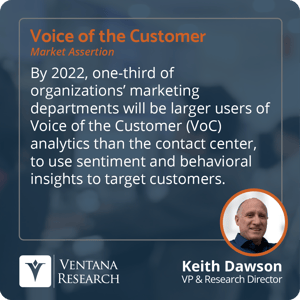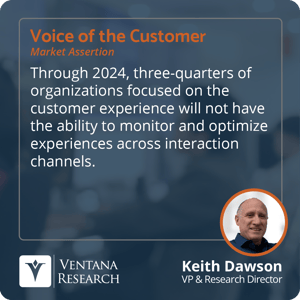Voice of the Customer (VoC) is a catch-all term that refers to the collection of customer feedback in various formats. Sometimes this feedback is in the form of quick surveys or reactions to questions like, "Did I resolve your issue today?" or "Would you recommend our service to a friend?" Alternatively, it can be derived from less specific but more numerous data signals that span multiple interactions or across a customer base. Most businesses make an effort to capture some customer feedback.
Tools for collecting VoC have historically been part of the suite of workforce optimization tools that contact centers use to manage agents. Enterprise feedback is used to rate the performance of agents and to spot process issues with specific customer interactions happening inside the contact center. In recent years, the use cases have expanded beyond the tactical activities of the center into a broader role across customer-experience teams. The modern understanding of VoC has evolved beyond the answers to survey questions, to incorporate sentiment, intent and behavior, and to measure those elements at multiple points in the customer journey.
The key issue with gathering VoC is knowing what to do with the feedback you are hearing. When it was perceived as tactical (and internal to the contact center), VoC was used to validate what had already happened; it was a way to correlate quantitative call-handling statistics (like the duration of calls and their dispositions) with the customer’s perspective on those same interactions. Modern VoC is more ambitious, providing insight about customers/into customer behavior that can be acted upon to create more revenue opportunities. When interpreted properly, VoC insights point out where an organization can find moments of influence or leverage that impact the customer experience and, ultimately, customer behavior.
In order to obtain these broader capabilities, vendors have augmented basic feedback tools. Many now capture data across contact channels, allowing for an expanded view into customer satisfaction beyond a single interaction or simply a customer’s reaction to a narrow slice (the interaction) of a longer customer journey.
This puts a premium on vendors’ ability to deliver interpretive tools alongside those for data capture. Changing VoC from a relatively passive operational activity into a comprehensive strategic effort requires advanced analytics and data integration among disconnected systems. Paradoxically, some vendors are shying away from using the term Voice of the Customer because traditionally it signifies the collection, rather than the analysis, of the data, and puts the contact center at the heart of the effort rather than a multi-team CX approach.
VoC is also merging with related efforts to collect feedback and insight from other stakeholders, most notably agents. As managers develop new post-pandemic techniques for workforce engagement, employee feedback – sometimes called “voice of the agent” or VoA – is a parallel data source presenting an alternative view of the company/customer relationship.
 These shifts will influence how organizations deploy technology in the coming years. VoC will be seen less as a contact-center tracking tool and more as one part of a comprehensive analytic effort conducted by teams across sales, service and marketing. Ventana Research asserts that by 2022, one-third of organizations’ marketing departments will be larger users of VoC analytics than the contact center, in order to use sentiment and behavioral insights to target customers. We expect having this kind of data will lead to greater collaboration between these teams, helping foster a more organization-wide view of customer experience than is common today.
These shifts will influence how organizations deploy technology in the coming years. VoC will be seen less as a contact-center tracking tool and more as one part of a comprehensive analytic effort conducted by teams across sales, service and marketing. Ventana Research asserts that by 2022, one-third of organizations’ marketing departments will be larger users of VoC analytics than the contact center, in order to use sentiment and behavioral insights to target customers. We expect having this kind of data will lead to greater collaboration between these teams, helping foster a more organization-wide view of customer experience than is common today.
 However, having the data and insights does not automatically result in positive outcomes. We also assert that through 2024, three-quarters of organizations focused on the customer experience will not have the ability to monitor and optimize experiences across interaction channels. This opens the door/leads the way for vendors to help organizations translate what they learn into new processes for orchestrating successful, personalized interactions that are tailored to the context discovered via VoC.
However, having the data and insights does not automatically result in positive outcomes. We also assert that through 2024, three-quarters of organizations focused on the customer experience will not have the ability to monitor and optimize experiences across interaction channels. This opens the door/leads the way for vendors to help organizations translate what they learn into new processes for orchestrating successful, personalized interactions that are tailored to the context discovered via VoC.
As the CX industry grows beyond the contact center, the market appears to prefer buying tools bundled into suites rather than as multiple point solutions. Even those who prefer niche solutions often prefer options that are combined into suite-like ecosystems of closely coordinated vendor offerings. The evolution towards CX suites will help vendors identify best practices in making the customer voice actionable.
The industry is also developing ways to make VoC data (in tandem with other data sources) useful in real time, using it to inform artificial intelligence (AI)-based agent-assist tools that can guide agents during interactions based on a wide range of contextual cues.
Buyers of VoC and other analytics tools will have to think ahead to who will use and interpret the information. Moving VoC somewhat out of the contact center raises questions about what user personas will interact with the tools, forcing conversations with vendors about different user interfaces, analytics skill levels and workflows. Buyers will have to consider the degree to which they want to endorse a wider, strategic use of VoC or continue with a more limited, interaction and survey-focused approach. These questions will inform the structure of the next generation of tools buyers deploy: suites versus point solutions and multi-departmental versus contact centers.
Vendors and buyers will have to work together very closely to align new VoC insights with organizational goals that rely on measures of customer loyalty and lifetime value. Both will have to connect VoC to business outcomes to demonstrate significant value from investment in more advanced analytics. I believe more educational programs are needed to show how VoC is part of a bigger effort to provide agents with assistance and guidance on next best actions. The relationships between capturing the voices of customers and agents, including cost-savings and revenue implications, is critical to understand.
Over five to ten years, it is likely that VoC will recede as a distinct process or practice as it becomes part of the wider practice of collecting data across channels and interaction points, and the parallel process of using AI and analytics to make intuitive leaps about how to engage customers. In the meantime, collecting data and interpreting it remain a solid way to respond to immediate issues and understand what customers expect.
For related insights on how data collection impacts the CX process, see the recent Analyst Perspective on Customer Data Platforms. For information on the multi-departmental aspects of CX procurement, see this Perspective on changing buying centers.
Regards,
Keith Dawson


 These shifts will influence how organizations deploy technology in the coming years. VoC will be seen less as a contact-center tracking tool and more as one part of a comprehensive analytic effort conducted by teams across sales, service and marketing. Ventana Research asserts that by 2022, one-third of organizations’ marketing departments will be larger users of VoC analytics than the contact center, in order to use sentiment and behavioral insights to target customers. We expect having this kind of data will lead to greater collaboration between these teams, helping foster a more organization-wide view of customer experience than is common today.
These shifts will influence how organizations deploy technology in the coming years. VoC will be seen less as a contact-center tracking tool and more as one part of a comprehensive analytic effort conducted by teams across sales, service and marketing. Ventana Research asserts that by 2022, one-third of organizations’ marketing departments will be larger users of VoC analytics than the contact center, in order to use sentiment and behavioral insights to target customers. We expect having this kind of data will lead to greater collaboration between these teams, helping foster a more organization-wide view of customer experience than is common today. However, having the data and insights does not automatically result in positive outcomes. We also assert that through 2024, three-quarters of organizations focused on the customer experience will not have the ability to monitor and optimize experiences across interaction channels. This opens the door/leads the way for vendors to help organizations translate what they learn into new processes for orchestrating successful, personalized interactions that are tailored to the context discovered via VoC.
However, having the data and insights does not automatically result in positive outcomes. We also assert that through 2024, three-quarters of organizations focused on the customer experience will not have the ability to monitor and optimize experiences across interaction channels. This opens the door/leads the way for vendors to help organizations translate what they learn into new processes for orchestrating successful, personalized interactions that are tailored to the context discovered via VoC.








